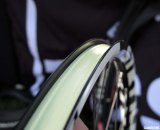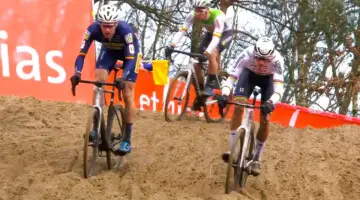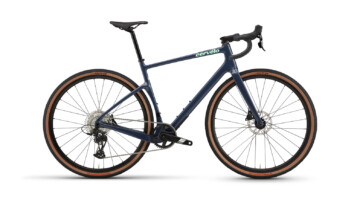
Tubeless has been gaining traction: WTB’s tubeless system borrows elements from the Stans / NoTubes.com system. © Clifford Lee / Cyclocross Magazine
It’s officially the offseason, and now’s the perfect time to experiment with your equipment and make upgrades before next season. And with the tough economic times, perhaps the tubular funds are smaller this year. It could be the time to try tubeless.
We’ve championed tubeless wheels since the early days of Cyclocross Magazine, and if you haven’t been around from Day 1 (this piece was from 2008!), here’s Part I of our tubeless primer, by Josh Patterson from our sold-out Issue 3. Part II of this series on going tubeless is here, and get ready for a lot more tubeless info heading your way this summer. Part III helps you choose some tires for conversion and make a DIY system.
Have a specific question about making the shift? Ask in the comments below!
For several years, ’cross racers have quietly been experimenting with their own tubeless setups. Tubeless setups for cyclocross have significant benefits over clinchers and can be considered a cost-effective alternative to tubular tires. The most popular tubeless cyclocross setup relies on rims designed for the growing 29er mountain bike market. For those not familiar with these big-wheeled behemoths, 29er is mountain bike jargon for 700c wheels.
Stan Koziatek, owner of NoTubes, has been designing rims and tubeless conversion kits for eight years. “My 29er rim is probably the best-kept secret in ‘cross racing,” says Koziatek. Cyclocrossers with mountain bike backgrounds were quick to see the benefits of using Koziatek’s rims for ’cross racing. Masters legend Gunnar Shogren has been pushing tubeless for years, and in his Issue 20 interview, you can find out why. Other prominent racers who’ve used Koziatek’s rims for cyclocross include Olympian Mary McConneloug, Canadian mountain and cyclocross powerhouse Geoff Kabush and fellow Canadian MTBer Mical Dyck, and singlespeed all-star Travis Brown.
Brown, the 2007 singlespeed cyclocross national champion runner-up, says, “They don’t have the same pinch resistance as tubulars, and you can’t run quite as low of pressure. But for the ease of setup, compared to gluing tubulars, the performance difference is small.” Brown likes the ability to swap tires with ease, and the greater variety of tread patterns make it easier to find a tire tread that’s just right for a specific race course.
Traction
When it comes to running tubes, Koziatek says the narrow road rims traditionally used for cyclocross work well for higher pressure tires. But, in a sport where running lower pressure to gain traction and reduce wheel deflection is vital, tubed setups on narrow rims have significant drawbacks. The lower the pressure, the more prone narrow rims are to rolling a tire or pinch-flatting a tube.
The rim most frequently used for tubeless ’cross setups, the 29er version of the ZTR 355, has an internal width of 19mm. For reference, that’s 4.5mm wider than the internal width of a Mavic Open Pro. The NoTubes rims’ greater width also helps when it comes to cornering. “With these rims you can really take advantage of the side tread,” says Larson.
Flat protection
Now, what happens when you run over a thorn or shard of glass? If you’re running tubes, you flat, DNF, or at least have a long run to the pits if you have spare wheels or a bike waiting. If you are running tubulars, you ride to the pits, crying over your expensive mishap. If you run tubulars with sealant, you go on about your merry way. And if you are running tubeless which relies on sealant, you also continue on your merry way. But you lose to the guy racing on tubulars because his wallet is lighter. This leads us to our next tubeless benefit.
The average racer does not have the option of having numerous wheelsets set up with tubulars for every conceivable riding condition. This is the consumer benefit of tubeless conversions—the ability to do more with less—to have one primary wheelset with tires that can be easily changed to suit course conditions.
In the Works
Tubeless tire systems first arrived on the scene for mountain bikes a decade ago, and have been improving ever since. In 2006, French tire manufacturer Hutchinson, working in conjunction with Shimano, launched a tubeless tire system for road use. Tubeless systems for cyclocross have been slow to catch on-this is no doubt due to the fact that tubular tires dominate the racing circuit.
But the tide is shifting. Cyclepath, a ’cross-friendly Portland bike shop, is a leader in tubeless setups for cyclocross. “We had a lot of naysayers the first few years,” says shop owner Bill Larson. Times have changed, and tubeless setups are now gaining popularity. “We’ve had riders in droves switching from tubulars to tubeless,” says Larson. The most popular cyclocross wheelset Cyclepath builds for its customer is built using 29er ZTR rims laced three-cross to 32-hole DT Swiss 240 hubs. Larson says his shop has put over 100 people on this setup with good results. Tubeless setups for cyclocross are likely to gain momentum in the next several years because they offers many of the benefits of tubulars without the high price of admission.
Hutchinson already makes two road tubeless-rated cyclocross tires: the Bulldog and Piranha (reviewed in Issue 3), while NoTubes has their own tubeless-ready cyclocross tire of their own dubbed “the Raven” that we previewed online and reviewed in Issue 4. This 700x35c tire has a fast-rolling dual compound tread, with aggressive side knobs. Issue 20 will feature reviews of a few new tubeless tire treads in our Tire Bonanza.
























